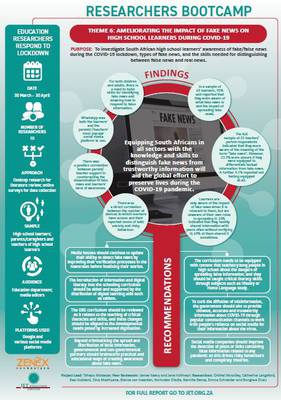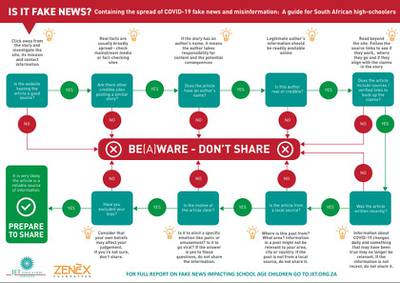Theme 6: Ameliorating the Impact of Fake News on High School Learners during COVID-19
Download the final report, infographic and tool
|
Download the research report for theme 6
|
View the infographic for theme 6
|
|
BACKGROUND
In the wake of the 2016 US elections, the words “fake news” started making international headlines. This was as a result of an election that was filled with too much information spread by the presidential candidates and their supporters, where social media became the bedrock in which fake news was spread. In the South African context, fake news has seen many stories being shared without being fact-checked, and those who normally do the fact-checking do so after the fact. This is how fake news gains credence in the life of society. It is an easy assumption that the problem of fake news can be seen as a binary between real and fake news; however, the problem is much deeper than that as fake can be seen as real and real as fake.
Meyer, writing for the Atlantic, contends that “Fake news and false rumours reach more people, penetrate deeper into the social network, and spread much faster than accurate stories”. This could be attributed to what has been described above as the ability of fake news to elicit strong emotions amongst its recipients. The real problem facing us is that many people lack skills that are needed in order to assess and evaluate information that comes from different sources of information. This lack of knowledge on how to assess the credibility of information has led to human beings being led by digital platforms and reduced to sharing information that has not been fact-checked, leading to the spread of fake news in some cases, mostly during times when people are awaiting credible updates.
TARGET GROUP
The term ‘school age children’ covers a very wide age range and speaks to varied levels of experience and skill in reading and comprehension of complex texts. It is more likely that older children, particularly those in secondary school, have direct access to social media and other online platforms and therefore are more likely to access fake news firsthand than younger children who rely on their parents or caregivers. For these reasons, our team has decided to limit our study to secondary school children.
RESEARCH AIMS
This research aims
- To be a source of information in the region by promoting and detailing methods of identifying fake information.
- To promote awareness and knowledge of the resources available to teacher, parents and learners that gather and #FactCheck information related to schooling during the COVID-19 epidemic.
- To curate resources that children, parents and teachers can use and learn skills in identifying fake news.
OUTCOME
The development of a communication platform that will list resources available to teachers, parents, and learners not only during the crisis but also in the weeks and months that follow.
Two main strands to the research are proposed:
1. Secondary school learners’ current engagement with fake news
- What kinds of fake news exist?
- How are these disseminated?
- Are there any forms of fake news directly targeted at secondary school children?
- How do secondary school learners currently engage with platforms through which they might encounter fake news?
- How do they respond to fake news currently? (As in, how do they evaluate what they read now, assess validity/reliability, critical thinking skills.)
- Has fake news impacted their behaviour, risk-taking or levels of anxiety? If so, in what ways?
- What have we as African school communities experienced and learned about epidemic conditions previously experienced on the continent that has helped us/our schools to be better prepared (e.g. Ebola)?
- What assumptions about fake news, adolescent engagement with online platforms, and the impact of fake news on adolescents, do we need to be aware of?
2. Ways in which secondary school children (and their parents and teachers) can build skills to identify and think critically about fake news, as well as deal with the impact it has on adolescents’ behaviour
- What resources are available to develop learners’ information literacy, media literacy, critical literacy and digital literacy skills?
- Are secondary school learners able to access these resources? If not, what are more suitable platforms for them?
- Do these resources deal with the psychosocial impact of fake news on adolescents? If not, how can this be compensated for, so that they have skills to deal with this impact?
- How can understandings of the curriculum be changed to include analysis of fake news as part of comprehension lessons? Or the Life Orientation curriculum?




